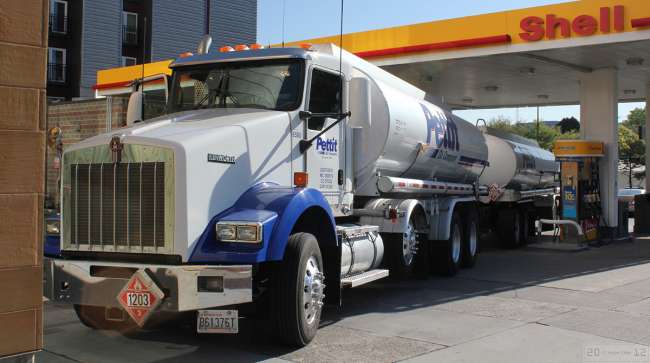Senior Reporter
Diesel Declines 2.7¢ to $3.043 a Gallon

[Stay on top of transportation news: Get TTNews in your inbox.]
The U.S. average retail price of diesel dropped 2.7 cents to $3.043 a gallon, the Department of Energy reported June 24. Crude oil prices jumped about 10% to more than $57 a barrel amid increased tensions in the Persian Gulf, then climbed higher later in the week.
Trucking’s main fuel costs 17.3 cents less than it did a year ago, when it was $3.216, DOE said.
U.S. average #diesel fuel price on 6/24/2019 was $3.043/gal, DOWN 2.7¢/gallon from 6/17/19, DOWN 17.3¢/gallon from year ago https://t.co/zJ4slhiTDQ #truckers #shippers #fuelprices pic.twitter.com/wKKE3eOEKE
— EIA (@EIAgov) June 25, 2019
Diesel fell in all regions of the country.
Also, the national average price for regular gasoline dropped 1.6 cents to $2.654 a gallon, DOE’s Energy Information Administration said.
Gasoline’s price has fallen for seven consecutive weeks, dropping 21.2 cents over that period.
“The month of May and the first half of June saw some big drops in the wholesale prices for gasoline and diesel,” Tom Kloza, co-founder and global head of energy analysis for the Oil Price Information Service, told Transport Topics. “Maybe 30% to 50% of those drops manifested themselves at the pump,” depending on the specific regional market.
At the same time, refineries operated at 94.2% of their capacity, EIA reported.
“We had a lot of refineries performing maintenance in anticipation of 2020 and wanting to make sure they have all their gear in order,” Kloza said.
U.S. average price for regular-grade #gasoline on 6/24/2019 was $2.654/gal, DOWN 1.6¢/gallon from 6/17/19, DOWN 17.9¢/gallon from year ago https://t.co/nVdiuay6xL #gasprices pic.twitter.com/FcwV4pACAu — EIA (@EIAgov) June 25, 2019
New rules from the International Maritime Organization requiring ships to use fuel with less than 0.5% sulfur will take effect Jan. 1. IMO currently prohibits the use of fuels with more than 3.5% sulfur, except when the ship’s equipment includes scrubbers to reduce sulfur emissions.
“Sulfur is going to be a big story in 2020” as demand for low-sulfur fuel increases, but so far the market is shrugging its shoulders, Kloza added.
Those wholesale prices for diesel and gasoline stabilized in the second half of June, Kloza added, because of the saber rattling around the Strait of Hormuz, which is a narrow body of water linking the Persian Gulf and the Gulf of Oman — and is the only sea route to the ocean from the Persian Gulf.
He also was watching the Group of 20 meeting, when President Donald Trump and China counterpart Xi Jinping sit down to discuss their trade dispute.
“If it is a success, commodities and stocks will move higher,” Kloza said.
“We’ll have skirmishes and the status quo,” he added, if the meeting proves to be inconclusive. The G-20 meeting also could expose some of the underlying issues and grave concerns about trade.
“Then the market could feel the macroeconomic pressure,” Kloza said. “When OPEC+ meets, we think they will likely continue the cuts that are set to expire after the first six months.”
The looming fear involves the macroeconomic factors — interest rates are getting near zero, and there is full employment, he said.
“Can it possibly get better? I hope so,” Kloza said, “but there are a lot of people who think it can get considerably worse.”
In the meantime, OPIS noted in an e-mail that it is expected gasoline — which is used by about 30% of the truck fleets — will broadly rally. Expectations are that 125,000 to 150,000 barrels a day of production will not return this driving season because of the spectacular fire and explosions that knocked out a large section of the Philadelphia Energy Solutions plant. The company later announced it would shut down the severely damaged refinery.
At the same time, “We’ve reached the halfway point in 2019,” OPIS wrote, “and it may feature some of the most belligerent rhetoric between the Trump administration and Iran.”
Bloomberg News reported that Trump questioned U.S. protections of oil-shipping routes in the Strait of Hormuz as tension flares with Iran after Tehran’s alleged attacks on tankers and downing of an American drone.
China gets 91% of its Oil from the Straight, Japan 62%, & many other countries likewise. So why are we protecting the shipping lanes for other countries (many years) for zero compensation. All of these countries should be protecting their own ships on what has always been.... — Donald J. Trump (@realDonaldTrump) June 24, 2019
“So why are we protecting the shipping lanes for other countries (many years) for zero compensation. All of these countries should be protecting their own ships,” Trump said June 24 on Twitter.
West Texas Intermediate crude futures on the New York Mercantile Exchange closed at $57.78 on June 24 compared with $51.74 per barrel June 17. On June 27, it pushed past $59 a barrel.
Meanwhile, U.S. commercial crude oil inventories decreased by 12.8 million barrels compared with the week ending June 14. It was the lowest level since September 2016.
Distillate fuel — primarily ultra-low-sulfur diesel used in transportation and to a lesser degree as heating oil — decreased by 2.4 million barrels and is about 7% below the five-year average for this time of year.
“There’s no shortage of dynamic factors,” Kloza said.




